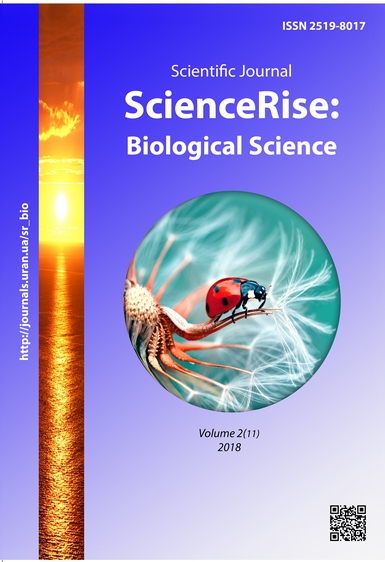Еnvironmental assessment of grouping coleoptera in broiler poultry farm
DOI:
https://doi.org/10.15587/2519-8025.2018.129566Keywords:
synanthropic species, grouping, cosmopolite, poultry farming, insecticides, pyrethroids, active substanceAbstract
Sampling of litter samples was carried out on broiler and parental poultry farms with different age stages of cultivation. The ecological features of formation of populations of synanthropic species of beetles are investigated. The influence of insecticides on the kind of darkling beetle is shown as one of the methods of preventing the spread of their population.
In the course of research it is shown that the microclimate of the poultry house and high temperatures are optimal for the development of harmful entomological fauna. The distribution of beetle populations depends on the term of growing poultry and mechanical damage to the litter.
It has been shown that insecticides are an optimal option to fight pests in poultry enterprises even in small doses. But due to their prolonged use, insects have developed resistance to drugs so they need to be changed with a certain periodicity which can be economically disadvantageous for the poultry industry and make significant financial expenses.
The article outlines the probable ways of pests in broiler and parental poultry farms and the negative effects of their spread. Such species of beetles as were identified – Alphitobius diaperinus, Trogoderma variabile and Sіtophhilus granaries
The insecticidal effect of pyrethroid drugs on the species A. diaperinus is shown, optimal harmful concentrations are calculated
References
- Lysytsyn, A. B., Tatulov, Yu. V., Chernukha, I. M. (2001). Mirovaya praktika formirovaniya kachestva myasnogo syirya i trebovaniya k nemu pererabatyivayuschey promyishlennosti [World practice of shaping the quality of meat raw materials and the requirements for processing industry]. Meat Industry, 9, 6–9.
- Holiuk, V. Ia., Holets, N. I. (2016). Analiz eksportu miasa kuriatyny v Ukraini: stan ta tendentsii rozvytku rynku [Analysis of the export of chicken meat in Ukraine: the state and trends of market development]. Market Infrastructure, 2, 131–135. Available at: http://market-infr.od.ua/journals/2016/2_2016_ukr/27.pdf
- Abdurakhmanov, H. M., Nabozhenko, M. V. (2001). Opredelitel i katalog zhukov-chernotelok (Soleoptera, Tenebrionidae s. str.) Kavkaza i yuga evropeyskoy chasti Rossii [Identifier and catalog of black beetles (Сoleoptera, Tenebrionidae s. str.) Caucasus and the south of the European part of Russia]. Moscow: Tovarischestvo nauchnyih izdaniy KMK, 361.
- Crook, Ph. G., Novak, I. A., Spilman, T. J. (1980). The lesser mealworm, Alphitobius diaperinus, in the scrotum of Rattus norvegicus, with notes on other vertebrate associations (Coleoptera, Tenebrionidae; Rodentia, Muridae). The Coleopterists Bulletin, 34 (4), 393–396.
- Chernei, L. S. (2009). Masove rozmnozhennia zhukiv-chornotilok (Coleoptera, Tenebrionidae) na ptakhofabrykakh [Mass reproduction of black beetles (Coleoptera, Tenebrionidae) in poultry farms]. Suchasne ptakhivnytstvo, 3 (76), 3–5.
- Chernei, L. S. (2005). Fauna Ukrainyi. Vol. 19, Issue 10. Zhestkokryilyie [Fauna of Ukraine. Vol. 19, Issue 10. Coleoptera]. Kyiv: Naukova dumka, 432.
- Baydakova, Yu. V. (1970). Zhestkokryilyie vrediteli hlebnyih zapasov i meryi borbyi s nimi v usloviyah yuga Ukrainyi [Coleoptera pests of grain stocks and measures to deal with them in the conditions of the south of Ukraine]. Оdessa, 160.
- Lobl, I., Smetana, A. (Eds.) (2008). Catalogue of Palaearctic Coleoptera. Stenstrup: Apolo Books, 669.
- Chernei, L. S., Fedorenko, V. P. (2006). Opredelitel zhukov–chernotelok faunyi Ukrainyi (imago, lichinki, kukolki) [Identifier of black beetles of Ukrainian fauna (imago, larvae, pupae)]. Kyiv: Koloobig, 247.
- Medvedev, H. S. (1965). Opredelitel nasekomyih Evropeyskoy chasti SSSR. Vol. II. Zhestkokryilyie i veerokryilyie [Identifier of insects of the European part of the USSR. Vol. II. Coleoptera and Strepsiptera]. Мoscow; Leningrad: Nauka, 356–380.
Downloads
Published
How to Cite
Issue
Section
License
Copyright (c) 2018 Olga Tertychna, Larysa Svaliavchuk, Olena Bryhas, Oleg Mineralov

This work is licensed under a Creative Commons Attribution 4.0 International License.
Our journal abides by the Creative Commons CC BY copyright rights and permissions for open access journals.
Authors, who are published in this journal, agree to the following conditions:
1. The authors reserve the right to authorship of the work and pass the first publication right of this work to the journal under the terms of a Creative Commons CC BY, which allows others to freely distribute the published research with the obligatory reference to the authors of the original work and the first publication of the work in this journal.
2. The authors have the right to conclude separate supplement agreements that relate to non-exclusive work distribution in the form in which it has been published by the journal (for example, to upload the work to the online storage of the journal or publish it as part of a monograph), provided that the reference to the first publication of the work in this journal is included.









